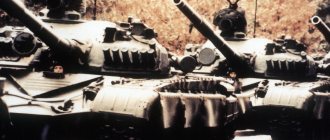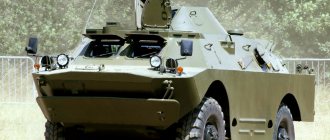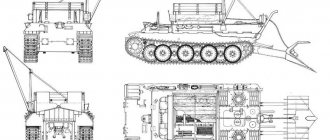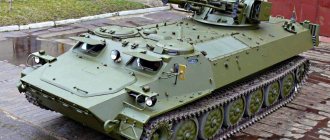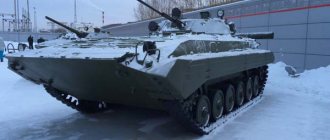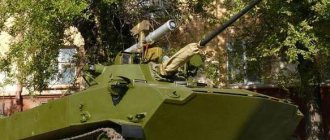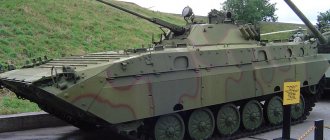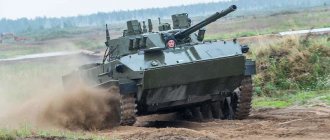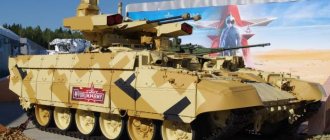Purpose
The Stryker armored personnel carrier is the main weapon of the US Army brigade combat teams that emerged in the 2000s. It is designed to transport motorized infantry units (usually a motorized infantry squad) to the battlefield with the ability for soldiers to fire directly from the vehicle, further fire support for infantry during and after dismounting, as well as for comprehensive support and combat operations of mechanized units of the US Army.
Models of armored vehicles (BT) of the Stryker family include 10 types of enhanced security vehicles that are in service with Stryker brigade combat teams. The first units entered service with the American army in February 2002; as of April 2013, 4,349 BT units of various types were delivered.
external reference
- Wikimedia Commons has a media gallery about Stryker
.
Official US Army websites
- Army Stryker website
- Stryker Brigade Combat Team Project Management Office
- 1st Brigade/25th Infantry Division and 3rd Brigade/2nd Infantry Division,
- 5th Brigade/2nd Infantry Division pages (broken link available at Internet Archive; see History, first and last version). and "172nd Stryker Brigade Combat Team". Archived from the original on July 18, 2006.
Other places
- General Dynamics Land Systems Canada Stryker Page
- General Dynamics Land Systems Canada Stryker Brochure
- Military Technology - Stryker
- Striker at howstuffworks.com
- Stryker destroys VBIED from a distance (video)
- Stryker photos and walks on Prime Portal
- Excerpt from International Defense Review article on Stryker Brigade battle groups, April 2006.
- Non-military website dedicated to Stryker brigade troops.
- Stryker information and images
- 2003 report critical of the Stryker program.
- Superman - Michael Yon's report that a Stryker named "General Lee" was blown up by an IED in Iraq, July 2007.
- STRYKER family of cars on YouTube.
| authoritative control |
|
- Data: Q612829
- Multimedia: Stryker AFV
History of creation
After the formal victory in the Cold War, US weapons turned out to be excessive for confrontation in low-intensity conflicts. On October 12, 1999, General E. Shinseki (who served as Chief of Staff of the US Army) officially announced a long-term plan for the transformation of the country's ground forces for the future, taking into account existing and future challenges and threats of our time. The program, called The Objective Force, articulated the US military's attempt to create a force that would be able to quickly respond to crisis situations in any region of the world, deploy in a timely manner to operational areas and dominate any conflict.
The program determined the Army's adaptation to the doctrine of flexible and relevant response to situations and required the availability of appropriate advanced weapons. The first phase of the program was the development of an intermediate version of the line of combat vehicles, called IAV (Interim Armored Vehicle - “Intermediate Armored Vehicle”). America's weapons at that moment did not have modern armored vehicles of this class.
The new line is designed to fill the gap in the capabilities of the ground forces to conduct the so-called “classic” type of wars, using heavy and powerful infantry combat equipment such as the M2 Bradley infantry fighting vehicle, or light and mobile, and at the same time weakly armed and protected equipment such as the M998 Hummer. . The main arena of combat operations for the armored vehicle model being created is low-level military conflicts.
Armored personnel carrier "Stryker"
Added by: Chief | Date: 01/23/2022 | Category: Army and weapons
The Stryker BTR is an Interim Armored Vehicle (IAV) also known as the Light Armored Vehicle III (LAV III). The vehicle is a development of the Piranha III armored personnel carrier of the Swiss company MOWAG GmbH. In October 2003, MOWAG joined the European division of General Dynamics' ground combat systems.
DEVELOPMENT AND PRODUCTION OF THE STRIKER APC
The development of the LAV-III was carried out in cooperation between General Motors Defense of Canada and General Dynamics Land Combat Systems Division in two versions simultaneously: an armored personnel carrier for transporting infantry (Infantry Carrier Vehicle, IFV) and a mobile fire support system (Mobil Gun System). Research and development work on the Stryker IAV armored vehicle began in October 1999, when US Army Chief of Staff General Eric Shinseki unveiled changes to the US Army 2010 Plan. Other changes made to the program included: the formation of “medium” brigades was envisaged as an “interim” measure; such brigades were called Interim Brigade Combat Teams. Stryker armored personnel carrier. IBCT - Intermediate Brigade Combat Team.
Initially, the US Army command had intentions of equipping the first unit with new wheeled combat equipment in March 2001. In order to satisfy this intention, the development of a new model of wheeled armored vehicle began immediately on the basis of an existing model. To begin with, a monitoring of wheeled armored vehicles in service with the US Army and the armies of other countries was carried out in order to select a “platform” for deep modernization. At first, the promising wheeled armored vehicle was called the Medium Armored Vehicle - a medium armored vehicle, later the name was changed to IAV. “I”, Interim – “intermediate”, since the armored vehicle was designed to fill the gap between the light armored vehicle HMMWV and the heavy M2 Bradley infantry fighting vehicle. There were no armored vehicles of this class in the US Army.
In February 2000, the US Army prepared a document that put forward an additional requirement for a promising armored vehicle - the ability to be transported by a C-130 Hercules military transport aircraft in a combat configuration. The armored vehicle could be either wheeled or tracked, capable of transporting an infantry squad of nine people with all standard weapons and equipment. In addition to the armored personnel carrier, as a basic option, the development of specialized variants was envisaged: a self-propelled mortar, an engineer squad transporter, an ATGM carrier, a reconnaissance vehicle, a fire support vehicle, a command and staff vehicle, a radiochemical reconnaissance vehicle, and a sanitary evacuation vehicle. It was not excluded that the vehicle would be designed to carry a 155 mm howitzer.
In November 2000, a test plan for the IAV armored vehicle was approved, and on November 16, 2000, a six-year contract worth about $4 billion was signed with the General Dynamics Land Combat Systems Division for the supply of LAV III armored vehicles for new intermediate brigade combat groups. Initially, it was planned to purchase 2131 LAV III armored vehicles for six combat brigade groups. The customer preferred the wheeled rather than the tracked version, as it best satisfied the stated requirements.
Other applicants for the lucrative order immediately harshly criticized the decision, noting that the Pentagon had actually sabotaged the competition. The protests had an effect - the GAO (General Accounting Office) - the "Accounts Chamber" of the US military program - imposed a ban on all work on the LAV III program. Work resumed only in April 2001, after a detailed audit by GAO specialists of each clause of the contract and the background of its conclusion. The production of armored vehicles was planned to be organized at three factories - in Annistone, pcs. Alabama, in Lima, pc. Ohio, and London, pc. Ontario.
On February 27, 2002, the vehicle received the official name "Stryker", both in honor of the prominent military hero Robert F. Stryker, who was awarded the Medal of Honor in Vietnam, and Private 1st Class Stuart S. Stryker, who was noted for his selfless heroism during World War II . Both soldiers fought bravely and fell on the battlefield.
Deliveries of Strykers to combat units began in April 2002, these were armored vehicles produced by factories in London and Annistone. On January 12, 2005, the industry reported to the US Republican Party and personally to US President George W. Bush about the construction of the 1000th LAV III Stryker armored vehicle. The honor of assembling the anniversary model of armored vehicles was given to the workforce of the enterprise in Ennistone.
About 800 LAV III armored vehicles entered service with the first three formed brigade combat groups. In December 2005, the customer received the first two of 17 ordered armored vehicles for radiochemical terrain reconnaissance. The US Army received the first Stryker in the M1128 MGS variant on May 15, 2006.
MODIFICATIONS OF THE STRIKER APC
The main variants of the Stryker are the M1126 ICV armored personnel carrier and the M1128 MGS fire support vehicle.
There are eight more modifications:
- — reconnaissance vehicle M1127, RV
- — self-propelled mortar M1129 version B, MCV-B
- — command post vehicle M1130, CV
- — fire support vehicle M1131, FSV
- - engineer squad vehicle M1132, ESV
- — ambulance recovery vehicle M1133, ESV
- - carrier of ATGM M1134, M1134
- - radiochemical reconnaissance vehicle M1135, NBSRV.
All options are 85% unified in terms of chassis and power plant, which simplifies the operation of the Stryker fleet in combat units.
ARMORED TRANSPORTER M1126 "STRIKER"
The M1126 Stryker armored personnel carrier is an armored personnel carrier for transporting infantry, ICV - Infantry Carrier Vehicle.
In addition to the two-person full-time crew, the armored personnel carrier is capable of transporting an infantry squad of nine people, although the cargo-passenger compartment of the vehicle is designed to carry 11 people.
The M1126 Stryker armored personnel carrier is the main type of armored vehicle of a brigade combat group; one group is armed with 127 such armored vehicles.
Armor protection
The body of the armored personnel carrier is welded from sheets of hardened armor steel grade 160. The armor also consists of Kevlar and ceramic-composite materials. The armor can withstand direct hits from bullets up to 14.5 mm caliber, bomb fragments and shells. If the armored personnel carrier is equipped with dynamic armor from the German company IBD/Deisenroth Engineering, the vehicle corresponds to level IV of protection according to STANAG-4569. At the same time, the armor protection of the Stryker IAV was easily penetrated by shots from RPG-7 hand-held anti-tank grenade launchers, which were widely used in Iraq by all sorts of illegal armed groups (the so-called “insurgents”).
The effective firing range of the RPG-7 is 500 m; a standard RPG-7 grenade with a cumulative warhead penetrates steel armor at distances of up to 400 m. RPG-7s are often equipped with rounds with tandem warheads, for which even dynamic protection is not an obstacle.
All Strykers sent to Iraq to participate in Operation Iraqi Freedom were equipped with additional armor kits designed to neutralize the threat from RPGs. A set of rack and pinion armor protection was installed around the perimeter of the armored car body, as a result of which the vehicle looked like a cage. The armor slats provoked the detonation of RPG shots before they came into contact with the vehicle body, thereby significantly reducing the damaging effect of the ammunition. The use of such armor was exclusively a temporary, interim measure, since only nine months were allotted for the development of measures to counter RPGs. The weight of the Slat rack armor set manufactured by General Dynamics for the Stryker armored personnel carrier is 2200 kg. A $5.9 million contract to equip all armored personnel carriers of one brigade combat group with rack armor was signed with General Dynamics in May 2006.
After installing rack armor, the width of the armored personnel carrier does not fit into the belly of the C-130 military transport aircraft. In addition, the Slat armor set makes it difficult for an armored personnel carrier to maneuver, especially on rough terrain and in urban areas. The vehicle's performance was also negatively affected by the increased weight after the installation of the overhead armor. In March 2005, a contract was signed with the land systems department of BAE Systems for the development and production of dynamic protection kits for 289 Stryker armored personnel carriers. The order was completed between September 2005 and October 2006. In February 2006, the first Stryker equipped with a dynamic protection kit was accepted by the customer. The armored personnel carrier's dynamic protection kit weighs 3,100 kg.
Engine and chassis
Similar to the Stryker IAV, the M1126 Stryker armored personnel carrier is a four-wheel drive, four-axle, eight-wheel armored vehicle. The armored car is equipped with a 6-cylinder liquid-cooled Caterpillar 3126 16 JP8 diesel engine with an electronic injector. Diesel allows an armored personnel carrier weighing 18.3 tons to reach a maximum speed of 101 km/h on the highway. Such diesel engines with a power of 350 hp. at 2500 rpm are also installed on medium 5-ton tactical trucks. If necessary, an armored personnel carrier with a diesel engine can drive very slowly - at a speed of only 2.5 km/h. The powerful diesel engine is installed in the engine compartment, which is located in the front right side of the vehicle. The engine is connected to an Allison MD-3066Р automatic transmission (six forward gears and one reverse gear). The Stryker's power plant also includes a two-speed gearbox and four automatic differentials, which can also be operated manually. A climate control system is mounted to the right of the engine. At first, climate control was not installed on the Strykers, but the operation of the vehicles in Iraq revealed an urgent need for air conditioners - the American military learned that it can be hot in Iraq not only figuratively, but also in the literal sense of the word (several vehicles sent to Iraq at first, they were equipped with engine heating systems for engine starts in severe frosts, installed instead of air conditioners).
Two fuel tanks are located on the sides at the rear of the hull. The range at a speed of 64 km/h is 450 km. The tanks are located outside the armored hull, so they are easily damaged by bullets and shrapnel. The wheel suspension is hydropneumatic and includes a machine height adjustment system that runs on nitrogen. A nitrogen tank is located under the floor of the transition from the control compartment to the fighting compartment. The hydropneumatic suspension ensures vehicle stability and comfortable conditions for the crew and landing force when driving even over very rough terrain and on all types of soil. The hydraulic system also includes hydraulic shock absorbers. The wheels consist of Hutchinson 20x8.5-inch wheels and reinforced Michelin XML 12.00 R20 tires. Ground clearance 51 cm.
With deflated tires, the car can travel up to 40 km at a speed of 48 km/h. Hydropneumatic brakes are installed on all eight wheels, the last three axles are equipped with an ABS system. To improve cross-country ability on soft pounds, the armored vehicle is equipped with a centralized system for regulating air pressure in pneumatic tires. "Stryker" is capable of overcoming vertical obstacles up to 60 cm high and 60-degree slopes. Even a 200 cm wide trench is no obstacle for this exceptionally passable vehicle! The Stryker, unlike the LAV III armored car, is not an amphibian, but overcomes water obstacles with depths of up to 130 cm along the bottom. The steering system is equipped with a hydraulic booster. The wheels of the two front axles are rotatable. The minimum turning radius of the machine is 16 m.
Crew workstations and C4ISR architecture
The driver's seat is well modern; it is located to the left of the longitudinal axis of the car. There is a large hatch in the roof of the hull above the driver’s seat, in the lid of which three M17E4 periscope observation devices are mounted. In the open position, the hatch is fixed in one of five positions to choose from. The hatch is locked from the inside and outside. A narrow tunnel leads from the control compartment to the fighting compartment. Usually, the tunnel is littered with all sorts of extremely valuable property, which is why access from the control compartment to the fighting compartment and vice versa is very difficult, not to say impossible. Workplace of the commander of an armored personnel carrier
Often two Javelin ATGMs are placed in the tunnel. The comfortable driver's seat is equipped with four ergonomic seat belts. Directly in front of the seat, in front of the steering wheel, there is a Raytheon AN/VAS-5 DVE (Driver's Vision Enhancer) display. The display is the output device of the passive infrared night vision system, which is equipped with many types of US Army equipment. This system allows the driver to confidently drive an armored personnel carrier in conditions of limited visibility, including at night and in conditions of a smoke screen. DVE system sensors are installed on the armor to the right of the driver's hatch. The image from the DVE system is transmitted to two displays.
In addition to the driver, the displays are installed at the infantry squad commander in the fighting compartment. To the left of the driver's seat there is a dashboard with a speedometer, tachometer, clock, pressure indicator in the fuel and oil systems, control units for fire extinguishing and climate control systems, a centralized system for regulating the pressure in pneumatics, and switches for lighting devices. Behind the instrument panel, on the wall of the tunnel, controls for an automatic chemical reagent detector are installed. To the right of the seat are the intercom and a removable engine access panel. The driver's seat is made adjustable in height. The pedals and steering column are also adjusted according to the driver's height.
The commander's seat is located immediately behind the engine on the right side of the hull. There is a hatch in the roof above the commander’s seat, into the cover of which are mounted as many as seven M17E4 periscope observation devices, in total giving the observer an almost all-round view. In the center of the hull roof, directly in front of the commander's hatch, a remote-controlled turret M151 RWS (Remote Weapon Station) from Kongsberg Defense and Aerospace is installed.
The Stryker is equipped with an innovative C4ISR (Command, Control, Communication, Computer, Intelligence, Surveillance and Reconnaissance) system integrated into the F8C82 (Force XXI Battle Command Brigade and Below) digital battle management system at the brigade level and below. The C4ISR system includes two ASIP radios, electromagnetic radiation warning system sensors, a video terminal, and navigation equipment with a satellite navigation system receiver. The video terminal displays an image “view from the M151 turret” or from the driver’s thermal imager. The second display, installed from the commander, displays maps of the area, messages from received and commanders, video images transmitted by airplanes and helicopters or other means of reconnaissance. When a digital map of the area is displayed on the screen, the location of friendly and enemy equipment and dangerous areas such as minefields are marked with icons on the map. The exchange of information between Strykers and other users of the F8C82 system is carried out in near real time.
M151 Remote Weapon System (RWS)
Universal remote-controlled turret M151 (RWS) System "Kongsberg Defense and Aerospace" M151 "Protector" is also mounted on combat vehicles M1130 "Stryker - CV", M1132 "Stryker - ESV", M1135 "Stryker - NBCRV", M1129 "Stryker MS-V" " The turret can be equipped with either a 40-mm Mk19 MOD-3 automatic grenade launcher or a 12.7-mm M2 NV machine gun. Additionally, it is possible to mount an M240V machine gun of 7.62 mm caliber. For remote guidance of the turret, a TIM thermal imager mounted on it and a VIM television camera equipped with a zoom lens are used. The built-in laser rangefinder determines the distance to the target at distances of up to 6000 m with an accuracy of 2.5 m. The weapon module rotates horizontally through an angle of 360 degrees, vertically – within the range from -20 to +55 degrees. The maximum rotation speed of the module is 60 degrees per second. Operating temperatures – from -40 to +60 degrees Celsius. Four blocks of M6 smoke grenade launchers are mounted on the turret. One block consists of six 66-m grenade launchers. Grenades are launched both collectively and individually. The basic ammunition load of the Stryker armored personnel carrier consists of 2000 rounds of 12.7 mm caliber for the M2 HB machine gun or 480 40 mm grenades for the Mk19 grenade launcher, as well as 16 66 mm smoke grenades. Boxes with cartridges or grenades are placed on the sides in the upper part of the hull or on the roof between the commander's hatch and the ventilation hatch.
In 2004, the US Army upgraded the M151 RWS system to the Block I level. The upgraded system was designated M151E1. The first M151E1 systems appeared on Strykers intended for the fifth brigade. Block I includes replacing the thermal imager with a more advanced IR device with an increased range and improved resolution; installation of a new television camera with a color display. The ergonomics of the commander's control handle for the M151 system have been improved. The dimensions of the ammunition box, which is mounted on the turret, have been increased. An ammunition consumption counter has been installed. Currently, work is underway to develop the M151 RWS block II system, which will be equipped with a stabilizer that allows targeted fire on the move at speeds of up to 40 km/h.
Troop squad Troop squad of the Stryker armored personnel carrier Nine heavily armed soldiers with full equipment enter and leave the armored personnel carrier through a huge self-powered ramp door at the rear of the vehicle. The ramp has a small door that opens outward to the right. Thus, in order to get inside or leave the armored car, it is not at all necessary to disturb the ramp drive. There are benches installed on the sides of the troop compartment; soldiers sit on them facing the longitudinal axis of the vehicle. Four sit on the right bench, five on the left. The infantry squad commander occupies the front seat on the left bench, facing forward, parallel to the armored personnel carrier commander. There is a quadrangular hatch in the roof of the hull above the landing commander's seat. There are two more ventilation hatches in the roof above the troop compartment. The dimensions of the hatches allow the soldier to stand on a bench and stick his head and shoulders into the roof opening, hitting the enemy with fire from his personal weapon. Hitting with a butt and stabbing with a bayonet while standing on a bench through an open hatch, however, is not very convenient. The troop compartment has mounts for a variety of soldier accessories, from personal weapons to toilet paper.
In the rear of the troop compartment, free space is left for storing the Javelin ATGM, four night vision goggles, spare barrels for the M240B machine gun, dry rations, etc. A heater is installed in the upper right corner of the ramp, next to it there are three filters for the system of protection against weapons of mass destruction. In the rear of the troop compartment, a lot of other useful items are stored, such as spare batteries, a portable radio, and a thermal imager. A lot of things fit inside the transport compartment, but its volume is still completely insufficient to accommodate all the items that any civilized soldier, a prominent example of which is the US Army soldier, urgently needs.
The armor has to carry part of the personal property of the infantrymen, spare ammunition, sapper tools, a tripod machine for the M240B machine gun, a tripod machine for a 12.7 mm machine gun or for a 40 mm automatic grenade launcher, equipment for cleaning weapons, canisters for water and fuel, camouflage network, field telephone. Most of the above items are placed in special luggage baskets along the sides of the hull. Additional systems
The Stryker armored personnel carrier is equipped with an FM200 automatic fire extinguishing system installed in the transport compartment and two FM25 automatic fire extinguishing modules in the engine compartment. In the engine compartment there are three optical fire sensors and two fire extinguishers with a Halon type composition. The transport compartment is protected from fire by three cylinders with “Halon”; one is installed next to the vehicle commander’s seat, the second is located next to the landing commander’s seat, and the third is mounted on the rear ramp. Four optical fire sensors are installed in the transport compartment. Based on commands from sensors, all three fire extinguishers work automatically (smoke, and then you won’t have any trouble). One portable fire extinguisher is attached next to the commander's seat of the armored personnel carrier. Rear ramp of the Stryker APC The Stryker has an auxiliary power unit located in the engine compartment. It is a small diesel engine that runs on an electric generator.
The armored personnel carrier is equipped with a collective system of protection against weapons of mass destruction, including various sensors, an “alarm” system and a Geiger counter, filter and ventilation units. In addition to the collective system, the standard equipment of the vehicle includes individual gas masks for crew members and troops. The ventilation system includes two fans, one for the driver and one for the landing party. The machine is equipped with a hydraulic winch with a traction force of 9525 kg. The winch is placed on the roof behind the driver's hatch. The speed at which the winch picks up the cable is approximately 6.5 m/min. The winch is equipped with one cable with a diameter of 16 mm. The length of the galvanized cable is 46 m. The rectangular air intake, covered with a mesh, is located to the right of the driver's hatch. Note the small inspection hatch that is located next to the large screened opening for engine exhaust. The engine exhaust gases are cooled to reduce the IR signature of the machine. At the rear of the hull roof there are two rectangular ventilation single-leaf hatches. The dimensions of the hatches are quite sufficient for soldiers with weapons to be pushed into them. On the front tire there is a fan cap and securing belts.
Air transportability
M1126 Stryker armored personnel carrier from the 2nd Squadron, 2nd Cavalry Regiment during Exercise Cougar Steel, December 2006.
One of the key elements of the Stryker concept was the ability to quickly deliver an armored vehicle to anywhere on Earth. Each Stryker brigade combat team is self-sufficient and has firepower comparable to that of a battalion of main battle tanks. Due to its relatively small mass, one Stryker can be transported by the C-130J Hercules transport aircraft. The C-17 Globemaster military transport aircraft carries three armored personnel carriers at once, and the C-5B Galaxy carries four.
Some modifications of the Stryker C-130 cannot be transported due to their significant weight or oversized dimensions for the Hercules. However, the global use of Strykers is possible on a massive scale only if they are transported by Hercules. We have to prepare cars for transportation in a special way. For example, smoke grenade launchers, the left trunk, antennas, a remote weapons module and the vertical travel limiters of the third axle wheels are removed from the M1126 ICV armored personnel carrier before loading onto the C-130. The operation of Strykers is not cheap.
The mileage of one Stryker per kilometer is estimated at $7.51, taking into account depreciation costs (for spare parts), but excluding the cost of fuel consumed. Every year, Stryker armored personnel carriers of the US Army cover 12,000-16,000 km. For the most part, wheeled armored vehicles travel on paved roads. The cost of operating Strykers is half the cost of operating M2 Bradley tracked infantry fighting vehicles. Of the 2,691 Strykers ordered, approximately 75% had been delivered by mid-2007.
Source: https://www.modernarmy.ru/article/413/btr-stryker © Modern Army Portal
Army equipment
After selecting several variants of armored personnel carriers, which were considered as a basis for the subsequent creation of armored fighting vehicles of a new family, the Canadian LAV III armored personnel carrier was taken as the basis. A few months after the start of testing, in November 2000, a purchase schedule for 2,131 copies of the Stryker combat vehicle was approved. The armored fighting vehicle entered the rapid reaction brigades.
The first cars were of only two types:
- Self-propelled gun M1128 (MGS) with a British 105-mm rifled Royal Ordnance L7 tank gun, which was installed on the first samples of American Abrams main battle tanks. These self-propelled guns were entrusted with the task of contact fire support in the battle of infantry units.
- The M1126 Stryker infantry armored personnel carrier (ICV), which replaced the obsolete M113 armored personnel carrier.
Requirements and regulations
According to the generals' plan, the new US weapons were supposed to be cheaper and more economical, while at the same time with a high degree of security and mobility. The undoubted advantage of the Strykers was that the maintenance of one strike brigade of armored vehicles of this type costs 25% less than the maintenance of a brigade group armed with heavier Bradley infantry fighting vehicles.
According to the regulations, a Stryker brigade combat team must be redeployed to any location on the planet within 96 hours, a division within 120 hours, and 5 rapid deployment divisions within 30 days. The Stryker is transported by air transporters C-5 Galaxy (4 combat vehicles), C-17 Globemaster III (3 units) and C-130 Hercules (1 unit), and after delivery the armored vehicles must be in full combat readiness for further action.
Users
ATGM M1134 "Stryker".
Current
- US
- Canada
- Thailand
- Saudi Arabia
- Morocco
Potential users
Israel
- Israeli Defense Forces - 3 units for testing only.
Chile
- Chilean Army: 2 units for testing only.
Iraq Iraq
- The Iraqi government, through the Foreign Defense Sales Program, has requested the possible acquisition of 400 Stryker aircraft for use by the Iraqi National Police. The order also includes 8 repair and recovery vehicles to support the Strykers. The Stryker was chosen over the previously favorable offer of the Canadian LAV-25. [ 3 ] [ ] [ ] [ ] The Iraqi Army is seeking to acquire at least 30 Stryker aircraft. [ 7 ]On July 25, 2013, Iraq submitted a formal request to purchase 50 units of ABQ M1135 armor protection for $900 million. [ 8 ]
Peru
- Peruvian Army: The US Department of Defense has approved the possible sale of 178 of these units to Peru.
Transportation difficulties
From the very beginning of testing this combat vehicle, problems arose with the armored personnel carrier meeting the tactical and technical requirements for which it was designed. Thus, the first samples of Stryker armored personnel carriers had technical difficulties with their transportation by C-130 Hercules transport aircraft. Due to the large width of the armored personnel carriers, there was no free space left in the aisles between the rows of seats and the equipment. Therefore, an incomplete squad could board the plane, which, in turn, created difficulties in the redeployment of troops to certain areas.
During the exercises, in order to fit the Stryker into the plane, the crew had to remove from it 2 smoke launchers, all the antennas, the left rear console, which blocked the vehicle from leaving the plane, the combat module on the turret, and some other units and parts. As a result, the department spent a lot of time setting up equipment after disembarking from the aircraft.
Vulnerabilities
In August 2003, the US Senate received a devastating report on the characteristics of the Stryker. The armored fighting vehicle was characterized as very unreliable and too expensive. The main emphasis was on the failure of General E. Shinseki's efforts to adopt a super-effective armored personnel carrier for the American army, which would meet all the challenges of modern conflicts.
The report criticized the high vulnerability of the Stryker family to conventional RPGs, which are equipped with militants and terrorists, and the excessive size of the armored personnel carrier, which did not allow the equipment to be transported without delay by C-130 Hercules aircraft.
Tests revealed low technical characteristics of the chassis of all modifications, be it the heavier M1128 wheeled tank or the relatively light M1126 armored personnel carrier. Problems arise when moving at high speeds and when moving over rough terrain. The Stryker also has poor stability - there have been cases of overturning on a regular highway.
mobility features
The vehicle can change the pressure in all eight tires to suit terrain conditions. The system warns the driver if the vehicle speed exceeds the recommended tire pressure. The tires are then automatically inflated to the set pressure. The system can also warn the driver of a flat tire, although the Stryker is equipped with run-flat tires, allowing the vehicle to travel several miles before the tire wears out completely.
Unlike many armored personnel carriers, the Stryker is not amphibious, but it can wade through water up to its wheels.
In August 2004, the USAF successfully confirmed the ability to airdrop a Stryker from a C17. In any case, it is too heavy to be lifted by helicopters.
Comparison with competitors
Critics of the wheeled armored personnel carrier point out that the Stryker is inferior in many respects to the modernized M113 tracked armored personnel carrier, and the M1128 self-propelled gun (MGS) is worse in all respects than the promising M8 AGS project. According to military experts, Stryker vehicles failed 7 out of 9 basic tests, compared with the M113A3, and in particular with its extended version MTVL. These are firepower, maneuverability off-road and in urban conditions, survivability, reliability, ability to be transported by air and convenience for the crew and troops. The elimination of identified deficiencies led to a significant increase in the cost of wheeled armored personnel carriers.
Specifications
The Stryker armored personnel carrier is practically identical in layout and configuration to its predecessor, the LAV III, but there are a number of differences. First of all, the height of the hull exceeds the prototype by 25-30 cm. This was done for the convenience of placing ammunition, crew and troops. To protect against mines and land mines, the bottom profile had to be altered, which led to an increase in the height of the hull to compensate for the useful volume in the troop compartment “eaten” by the V-shaped bottom. The linear dimensions have also changed slightly.
The wheeled BT has a classic layout typical for vehicles of this class: the engine and transmission compartment is located in the front right, and the control unit with the driver's seat is located in the front left. Behind the driver is the commander of the vehicle. The middle compartment and aft part are allocated for the troop compartment, which accommodates 9 fully equipped infantrymen. The roof of the hull is equipped with hatches above the appropriate places for the crew to board; the troops disembark through the aft doors; emergency hatches are also provided above the troop compartment.
References
- https://web.archive.org/web/20110827205305/https://www.tanknutdave.com/component/content/article/101
- "SBCT Project Management Office". Archived from the original on July 22, 2006.
- “The Iraqi military is planning large arms purchases” (unspecified). December 12, 2008.
- Wikimedia Commons has media related to Iraq. Defense Security Cooperation Agency. December 10, 2008. Archived from the original on September 27, 2011. Retrieved December 4, 2009.
- "Iraq buys what it knows". strategypage.com. December 18, 2008.
- Finding LAVs in all the right places - Defenseindustrydaily.com, December 11, 2008 (in English)
- Quote error: Invalid tag ; the contents of the links being called are not definedIraq buy
- DSCA Press Release. Archived August 6, 2013, at the Wayback Machine. – DCSA.mil, July 25, 2013
- army.million
- globalsecurity.org
- protection-update.com
Reservation of the Stryker armored personnel carrier
The armored fighting vehicle is less vulnerable to small arms fire than previous M113-type armored personnel carriers. The body is welded from armor plates up to 12 millimeters thick. Due to the use of different types of steel, the protection corresponds to the fourth level of the STANAG 4569 standard in the frontal projection, and the second or third level in other projections. Additionally, the Strykers can be equipped with screens around the entire perimeter of the hull.
The armor protects against small arms bullets with a caliber of up to 14.5 mm from the stern and sides, from 30 mm shells into the frontal part of the hull at distances of more than 500 meters (with passive protection), as well as from damage from 152 mm fragmentation shells that exploded near.
Modifications
- The M1126 Infantry Armored Vehicle (ICV) is the primary armored personnel carrier of the Stryker family, designed to transport motorized infantry and fire support.
- Modification of the M1126 for reconnaissance, security, patrol, communications, ammunition delivery, etc.
- M1126 with a reinforced bottom DVH-Scout (ICCV-S), designed for military reconnaissance, for which it is equipped with a long-range surveillance complex.
- The M1127 (RV) is a combat reconnaissance vehicle designed for reconnaissance, security and surveillance on the battlefield. Equipped with specialized long-range reconnaissance equipment from Raytheon.
- M1128 (MGS) - self-propelled artillery unit (wheeled tank) with a 105 mm rifled gun.
- M1129 (MCV-B) is a self-propelled 120 mm mortar with a fixed and detachable configuration.
- M1130 (CV) – command BT.
- M1131 (FSV) - fire control vehicle.
- M1132 (ESV) is an armored engineering vehicle designed to conduct engineering reconnaissance, transport and support sappers.
- M1133 (MEV) – medical BT.
- M1134 ATGM - anti-tank missile system. The vehicle has a remote installation for launching anti-tank guided missiles from the ground.
- M1135 (NBCRV) - designed for conducting radiation, chemical, and bacteriological reconnaissance of the area.

